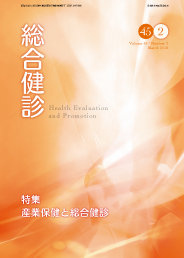Volume 47, Issue 2
Displaying 1-10 of 10 articles from this issue
- |<
- <
- 1
- >
- >|
Special Features
Medical Care for Non-Japanese Individuals Through Health Evaluation and Promotion
-
Article type: Special Feature
2020Volume 47Issue 2 Pages 301-306
Published: March 10, 2020
Released on J-STAGE: September 05, 2020
Download PDF (1443K) -
Article type: Special Feature
2020Volume 47Issue 2 Pages 307-314
Published: March 10, 2020
Released on J-STAGE: September 05, 2020
Download PDF (1580K) -
Article type: Special Feature
2020Volume 47Issue 2 Pages 315-322
Published: March 10, 2020
Released on J-STAGE: September 05, 2020
Download PDF (3495K) -
Article type: Special Feature
2020Volume 47Issue 2 Pages 323-328
Published: March 10, 2020
Released on J-STAGE: September 05, 2020
Download PDF (1123K) -
Article type: Special Feature
2020Volume 47Issue 2 Pages 329-333
Published: March 10, 2020
Released on J-STAGE: September 05, 2020
Download PDF (1741K)
Original Articles
-
Article type: Original Article
2020Volume 47Issue 2 Pages 334-344
Published: March 10, 2020
Released on J-STAGE: September 05, 2020
Download PDF (1844K) -
Article type: Original Article
2020Volume 47Issue 2 Pages 345-351
Published: March 10, 2020
Released on J-STAGE: September 05, 2020
Download PDF (1167K) -
Article type: Original Article
2020Volume 47Issue 2 Pages 352-356
Published: March 10, 2020
Released on J-STAGE: September 05, 2020
Download PDF (1479K)
Brief Report
-
Article type: Brief Report
2020Volume 47Issue 2 Pages 357-363
Published: March 10, 2020
Released on J-STAGE: September 05, 2020
Download PDF (1109K)
ERRATUM
-
2020Volume 47Issue 2 Pages 427-428
Published: March 10, 2020
Released on J-STAGE: September 05, 2020
Download PDF (755K)
- |<
- <
- 1
- >
- >|
